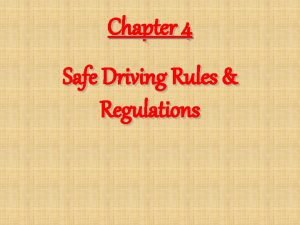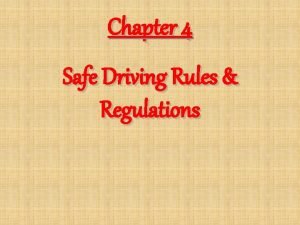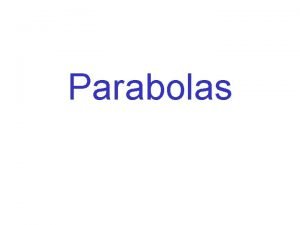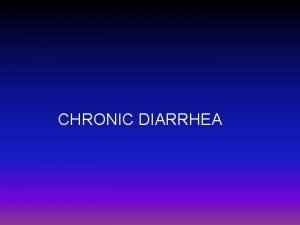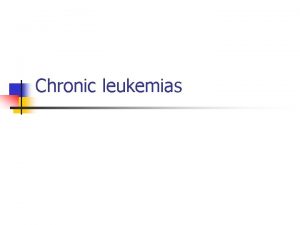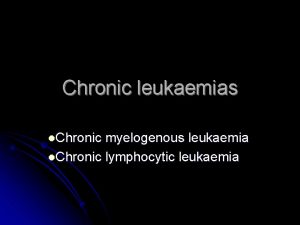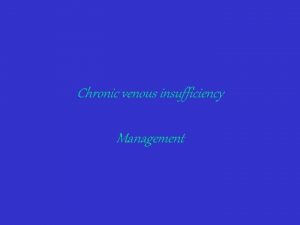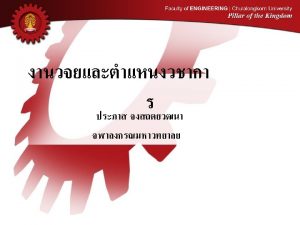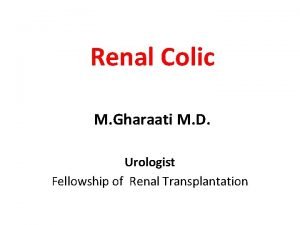What pediatric urologist should know on the chronic








































- Slides: 40

What pediatric urologist should know on the chronic renal insufficiency/chronic renal failure and renal replacement therapy in children (Cooperation with a pediatric nephrologist) Postgraduate teaching course, Prague, October 16, 2005 Prof. Janda, MD Dptm. of Pediatrics, Section for Pediatric Nephrology University Hospital Motol, Prague, CZ

Chronic renal insufficiency and chronic renal failure in children n This issue constitutes a stimulating challenge for the pediatric nephrologist, but also for the pediatric urologist. n Pediatric urologist must be an integrated member of the team taking care of patients with this diagnosis

Prenatal diagnosis and severe congenital anomalies of urinary tract Major development in dialysis and other elimination methods (renal replacement therapy = RRT) improved significantly the prognosis of CRI/CRF in this age. n Cooperation with pediatric urologists starts even before the child´s birth (prenatal ultrasound diagnosis, even prenatal surgery!!), particularly in children severe anomalies n

Prenatal diagnosis and severe congenital anomalies of urinary tract Some of these inborn defects may result in early deterioration of renal function resulting and a severe complex of problems (impact on thriving, normal somatic/psychical development, growth, etc. , still prior the renal replacement therapy is necessary.

To understand each other, the common nomenclature is useful Chronic renal insufficiency (CRI) in children is mostly defined as plasma creatinine level (Pcr)> 2 mg%= 2 mg/dl, i. e. ca 176 μmol/L (and >ca 130 μmol/L in infant and toddlers) lasting longer than 6 months (to avoid temporary creatinine elevation, e. g. after acute renal failure).

Grading of the chronic renal insufficiency according the GFR Stage 1. Kidney damage with normal or even increased GFR (higher than 90 ml/min/ 1. 73 m 2) Stage 2. Mild decrease of GFR (between 60 -89 ml/min/ 1. 73 m 2 ) Stage 3. Moderate decrease of GFR (between 30 -59 ml/min/ 1. 73 m 2 )

Grading of the chronic renal insufficiency according the GFR Stage 4. Severe decrease of GFR (between 15 -29 ml/min/ 1. 73 m 2 ) Stage 5. Chronic renal failure (GFR lower than 15 ml/min/ 1. 73 m 2 - see below! In this proposal the lower limit of GFR is not more 80 ml/min/ 1. 73 m 2 l, but 90 ml ml/min/ 1. 73 m 2!! n American National Kidney Foundation (2002)

Definition of chronic renal failure Chronic renal failure (CRF) is defined as End Stage Renal Disease (ESRD) requiring Renal Replacement Therapy (RRT) n This situation may be also called as „renal death“. The kidneys are not more able to fulfill their basic function and without an active intervention (dialysis or successful renal transplantation) the patients cannot survive. n

What GFR -value heralds situation when RRT is necessary? Unfortunately, it is not possible to set the exact level of Pcr, mostly the Pcr reach some 700 - 800 μmol/L in school children, but the intervention RRT may become urgent at much lower levels in toddlers or even in infants. Exceptionally, RRT may commence with normal GFR! (congenital nephrotic syndrome)

Evaluation of renal function, also for paediatric urologists: n Glomerular filtration rate (GFR) may be assessed using the classical test (creatinine clearence with the urine-collection This procedure is limited, particularly in infants, toddlers, pre-school children (inaccurate urine collection). n Attempts to use Cystatin A as a marker of GFR n

Simple assessment of GFR in children older than 1 year The following equation introduced by Schwartz in 70 thies is used as a routine worldwide: n GFR= (body heightcm x 48 n Pcr (μmol/L) This equation gives the GFR in ml/Min. /1. 73 m 2 BSA and may be used approximately since the first birthday. The problem is, the Schwartz formula does not work so good in children with very high plasma creatinine levels. n n n

The plasma creatinine level is agedependent (better height-dependent). n n n There is another useful equation you can calculate the upper limit of plasma creatinine level (Pcr maximal ) in childhood: Pcr(max)= heightcm x 0. 61 So, e. g. the maximal creatinine level (in umol/L) in a child aged 2 years (having height some 86 cm) must not exceed 53 μmol/L)which is in adults out of range (but too low!! )

Incidence of chronic renal insufficiency in children Epidemiology of the CRI/CRF in children: The incidence of CRI in childhood (taken as GFR lower than ca 80 ml/ Min. /1. 73 m 2/) does not differ substantially worldwide, the figures show ca 7 -10 cases pmcp/ 1 year (pmcp= per million children population) new nomenclature: pmarp = per million of age related population

The incidence/prevalence of CRI/CRF/RRT (European Pediatric Registry) n n The former European register of EDTA collapsed in 1994, but now some new data are already available: more than 3000 patients aged less than 20 years and starting RRT between 1980 and the end of 2000 registered. The incidence of End-Stage Renal-Disease rose from 7. 1 pmcp in the 1980 -1984 to 9. 9 pmarp in the 19851989 and remained stable thereafter. The prevalence of RRT increased from 22. 9 pmcp in 1980 to as high as 62. 1 pmarp in 2000.

The prevalence of CRF/RRT= children surviving on RRT (from the European Pediatric Registry) n The prevalence data range between 0 in some developing countries to ca 50 patients pmcp or even more in developed countries. The correlation is often difficult (different criteria, different definition of the child- up 15 or up 18, or even up 20 years). n Higher figures of prevalence occurring in the last years are on account of infants and toddlers included in RRT program

Number of New Patients Entering RRT over Time (pmarp) Per million age related population

Incidence of chronic renal failure in children/adolescents Among the children population on RRT the school children and adolescents prevail (ca 3545% and ca 30% resp. ). n The proportion of preschool children, toddlers and infants is lower than 10%, but an increasing tendency is reported during the last years (emerging ethical issues in newborns and infants with combined handicap) n

Primary Renal Disease by Gender (pmarp) Per million age related population (0 -19 yrs)

What are the symptoms of chronic renal insufficiency? n n n Diuresis decreased, not always! E. g. polyuria is often the leading symptom in nephronophtisis resulting in secondary bed wetting (a possible pitfall for urologists examinig children with enuresis !!) Anaemia (paleness), headaches (hypertension) Growth retardation (growth charts - tracking phenomen) Losing the body weight

What are the symptoms of chronic renal insufficiency? n Fatigue, drowsiness, losing appetite, restriction of physical activities (sport), sleeping following an interesting TV-programme, movies n School: sleeping during the classes and unexpected bad notes, limited contacts with classmates Losing interest on previous interesting activities n

Conservative treatment of CRI Fluid and salts intake n Acidobasic regulation (bicarbonate) n Phosphate-binding drugs (Ca++free drugs preferred) n Diet- restriction in children mostly not recommended, caloric intake often only via nasogatrig tubing or PEG! n Vitamins- D-vitamin derivates (Rocaltrol, D- no polyvitamines compounds (avoid A and E!! ) n

Fluids loss and its management n Very important message for paediatric urologists: relevant fluid loss (diarrhea, vomiting) may result in low blood pressure and limited kidney blood supply - sequel is a decrease of GFR! n Mostly, there is a recovery of this complication after early rehydration, but very often, the value of GFR does not return to original level! The parents must be informed on this emergency situation and early fluid parenteral application must be provided!

Conservative treatment of CRI Erythropoetin fighting the severe anaemia n Antihypertensive treatment if high blood pressure present n Growth hormon- starting early! n Message for surgeons: avoid damage of vessels in arms (then later possible problems with construction of the shunt -fistula) n

Decision to start the renal replacement therapy in children Complex evaluation by_ n paediatric nephrologist n paediatric urologist n primary care pediatrician n team of nurses n psychologist, teachers and then n FAMILY n

Indication for the RRT Main difference in RRT in children x adults: n Commencement of RRT in this age automatically takes in account the renal transplantation. n Reason: even the best long lasting dialysis cannot provide an appropriate development/growth in paediatric patients and it is an immense burden (very often higher stress for the family than for the child!) n

Preparation for renal replacement therapy Discussion with parents/children, decision to start the RRT n To present posibilities of: n u a) hemodialysis u b) peritoneal dialysis u c) preemptive renal transplantation (mostly using a graft from relative living donor) u d) witholding of the active treatment (ethical issue)

Treatment modalities in children Hemodialysis: earlier the most common form of RRT, but peritoneal dialysis became popular by the end of 80 s. Today, the children are mostly treated at home by automated peritoneal dialysis=APD, using “cyklers” n Pre-emptive renal transplantation (renal transplantation without previous dialysis) accounted for 18% of the first treatment modality in the 1995 -2000 treated children. n












Team of the paediatric dialysis-transplantation center Paediatric nephrologists n Specialized nurses, dieticians n Surgeons- pediatric urologist, vascular surgeon n Anesthetist n Psychologist, social worker n Teacher n Close contacts with the family n

Thank you for your attention An offer from UNEPSA: to put the abstracts of your postgraduate teaching course (may be even the power-point presentation) on the www. unepsa. org
 Pediatric urologist in atlanta ga
Pediatric urologist in atlanta ga Longtitu
Longtitu Rohan hall urologist
Rohan hall urologist Icd10 urologist
Icd10 urologist Dr. gluck urologist
Dr. gluck urologist Normalizing flow
Normalizing flow God of angel armies
God of angel armies Know history know self
Know history know self Common things everyone should know
Common things everyone should know A motorist should know that he she is entering
A motorist should know that he she is entering Center line font
Center line font What should every efl teacher know pdf
What should every efl teacher know pdf How to find the focus
How to find the focus Jeff dean latency numbers
Jeff dean latency numbers Các môn thể thao bắt đầu bằng tiếng chạy
Các môn thể thao bắt đầu bằng tiếng chạy Sự nuôi và dạy con của hổ
Sự nuôi và dạy con của hổ điện thế nghỉ
điện thế nghỉ Các loại đột biến cấu trúc nhiễm sắc thể
Các loại đột biến cấu trúc nhiễm sắc thể Nguyên nhân của sự mỏi cơ sinh 8
Nguyên nhân của sự mỏi cơ sinh 8 Trời xanh đây là của chúng ta thể thơ
Trời xanh đây là của chúng ta thể thơ Chó sói
Chó sói Thiếu nhi thế giới liên hoan
Thiếu nhi thế giới liên hoan Vẽ hình chiếu vuông góc của vật thể sau
Vẽ hình chiếu vuông góc của vật thể sau Một số thể thơ truyền thống
Một số thể thơ truyền thống Các châu lục và đại dương trên thế giới
Các châu lục và đại dương trên thế giới Thế nào là hệ số cao nhất
Thế nào là hệ số cao nhất Frameset trong html5
Frameset trong html5 Hệ hô hấp
Hệ hô hấp Tư thế ngồi viết
Tư thế ngồi viết Bảng số nguyên tố lớn hơn 1000
Bảng số nguyên tố lớn hơn 1000 Hát kết hợp bộ gõ cơ thể
Hát kết hợp bộ gõ cơ thể đặc điểm cơ thể của người tối cổ
đặc điểm cơ thể của người tối cổ Cách giải mật thư tọa độ
Cách giải mật thư tọa độ Glasgow thang điểm
Glasgow thang điểm ưu thế lai là gì
ưu thế lai là gì Thẻ vin
Thẻ vin Cái miệng bé xinh thế chỉ nói điều hay thôi
Cái miệng bé xinh thế chỉ nói điều hay thôi Các châu lục và đại dương trên thế giới
Các châu lục và đại dương trên thế giới Từ ngữ thể hiện lòng nhân hậu
Từ ngữ thể hiện lòng nhân hậu Bổ thể
Bổ thể Tư thế ngồi viết
Tư thế ngồi viết









